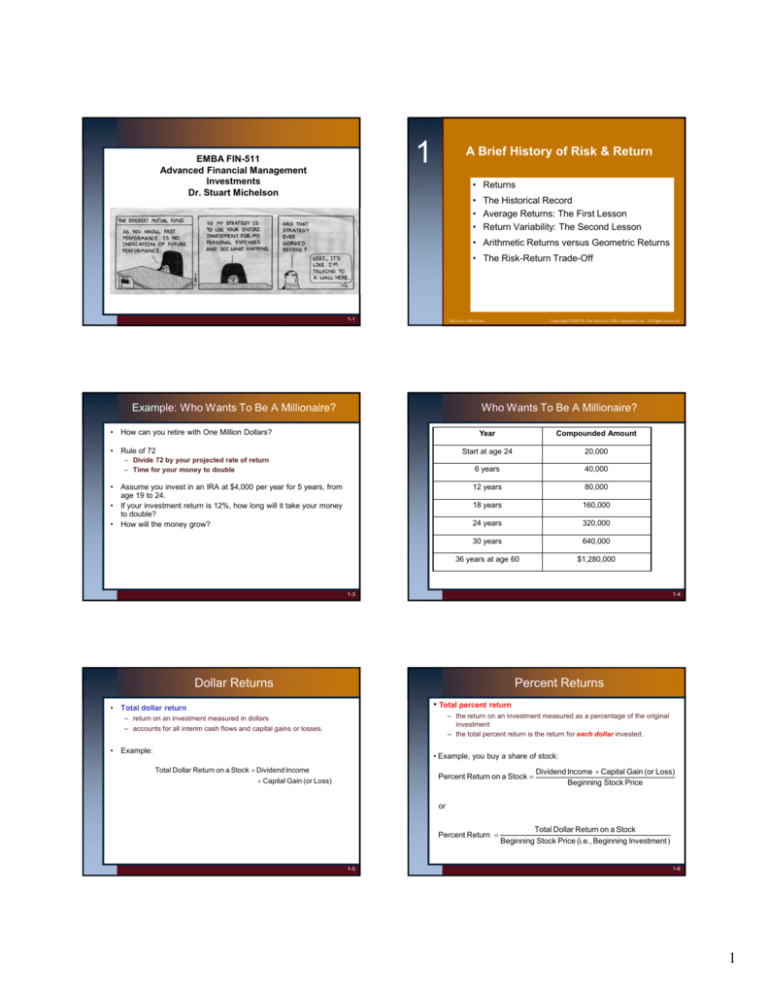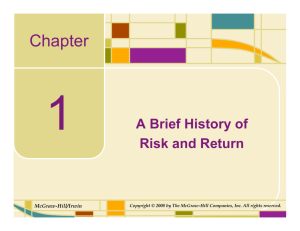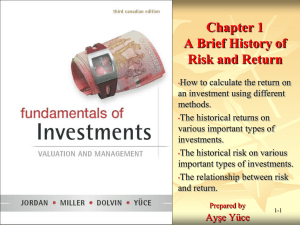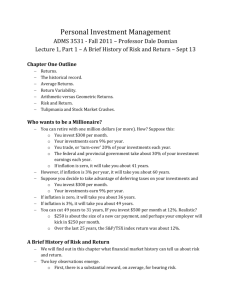
1
EMBA FIN-511
Advanced Financial Management
Investments
Dr. Stuart Michelson
A Brief History of Risk & Return
• Returns
• The Historical Record
• Average Returns: The First Lesson
• Return Variability: The Second Lesson
• Arithmetic Returns versus Geometric Returns
• The Risk-Return Trade-Off
1-1
Example: Who Wants To Be A Millionaire?
•
How can you retire with One Million Dollars?
•
Rule of 72
Who Wants To Be A Millionaire?
– Divide 72 by your projected rate of return
– Time for your money to double
•
•
•
1-2
Copyright © 2005 by The McGraw-Hill Companies, Inc. All rights reserved.
McGraw-Hill/Irwin
Assume you invest in an IRA at $4,000 per year for 5 years, from
age 19 to 24.
If your investment return is 12%, how long will it take your money
to double?
How will the money grow?
Year
Compounded Amount
Start at age 24
20,000
6 years
40,000
12 years
80,000
18 years
160,000
24 years
320,000
30 years
640,000
36 years at age 60
$1,280,000
1-3
1-4
Dollar Returns
•
Percent Returns
• Total percent return
Total dollar return
– the return on an investment measured as a percentage of the original
investment
– the total percent return is the return for each dollar invested.
– return on an investment measured in dollars
– accounts for all interim cash flows and capital gains or losses.
•
Example:
• Example, you buy a share of stock:
Total Dollar Return on a Stock = Dividend Income
Percent Return on a Stock =
+ Capital Gain (or Loss)
Dividend Income + Capital Gain (or Loss)
Beginning Stock Price
or
Percent Return =
1-5
Total Dollar Return on a Stock
Beginning Stock Price (i.e., Beginning Investment )
1-6
1
Example: Calculating Total Dollar
and Total Percent Returns
•
•
•
Suppose you invested $1,000 in a stock with a share price of $25.
After one year, the stock price per share is $35.
Also, for each share, you received a $2 dividend.
•
What was your total dollar return?
–
–
–
–
•
A $1 Investment in Different Types
of Portfolios, 1926—2006.
$1,000 / $25 = 40 shares
Capital gain: 40 shares times $10 = $400
Dividends: 40 shares times $2 = $80
Total Dollar Return is $400 + $80 = $480
What was your total percent return?
– Dividend yield = $2 / $25 = 8%
– Capital gain yield = ($35 – $25) / $25 = 40%
– Total percentage return = 8% + 40% = 48%
1-7
1-8
The Historical Record:
Total Returns on Large-Company Stocks.
Financial Market History
1-9
The Historical Record:
Total Returns on Small-Company Stocks.
1-10
The Historical Record:
Total Returns on U.S. Bonds.
1-11
1-12
2
The Historical Record:
Total Returns on T-bills.
The Historical Record:
Inflation.
1-13
Historical Average Returns
•
A useful number to help us summarize historical financial data is the
simple, or arithmetic average.
•
From Table 1.1, add up the returns for large-company stocks from
1926 through 2006, which is 996%
•
There are 81 returns, so the average return is about 12.3%.
•
What’s this mean?
•
If you are making a guess about the size of the return for a year
selected at random, your best guess is 12.3%.
•
The formula for the historical average return is:
1-14
Average Annual Returns for Five Portfolios
n
Historical Average Return =
∑ yearly return
i =1
n
1-15
Average Annual Risk
Premiums for Five Portfolios
Average Returns: The First Lesson
•
Risk-free rate: The rate of return on a riskless, i.e., certain
investment.
•
Risk premium: The extra return on a risky asset over the riskfree rate; i.e., the reward for bearing risk.
•
The First Lesson: There is a reward, on average, for bearing
risk.
•
By looking at Table 1.3, we can see the risk premium earned by
large-company stocks was 8.5%!
1-16
1-17
1-18
3
Why Does a Risk Premium Exist?
Return Variability: The Statistical Tools
•
•
Modern investment theory centers on this question.
•
We can examine part of this question by looking at the dispersion,
or spread, of historical returns.
•
We use two statistical concepts to study this dispersion, or
variability: variance and standard deviation.
•
The Second Lesson: The greater the potential reward, the greater
The formula for return variance is:
∑ (R
N
VAR(R) = σ 2 =
•
i =1
i
−R
)
2
N −1
The standard deviation
SD(R) = σ =
VAR(R)
the risk.
•
Normal distribution
1-19
1-20
Example: Calculating Historical Variance
and Standard Deviation
Frequency Distribution of Returns on
Common Stocks, 1926—2006
•
Let’s use data from Table 1.1 for Large-Company Stocks.
•
The spreadsheet below shows us how to calculate the average, the
variance, and the standard deviation (the long way…).
(1)
(2)
Year
1926
1927
1928
1929
1930
Sum:
Return
11.14
37.13
43.31
-8.91
-25.26
57.41
Average:
11.48
(3)
Average
Return:
11.48
11.48
11.48
11.48
11.48
(4)
Difference:
(2) - (3)
-0.34
25.65
31.83
-20.39
-36.74
Sum:
(5)
Squared:
(4) x (4)
0.12
657.92
1013.15
415.75
1349.83
3436.77
Variance:
859.19
Standard Deviation:
29.31
1-21
Historical Returns, Standard Deviations, and
Frequency Distributions: 1926—2006
1-23
1-22
The Normal Distribution and
Large Company Stock Returns
1-24
4
Arithmetic Averages versus
Geometric Averages
Returns on Some “Non-Normal” Days
•
The arithmetic average return answers the question: “What was
your return in an average year over a particular period?”
•
The geometric average return answers the question: “What was
your average compound return per year over a particular
period?”
•
When should you use the arithmetic average and when should
you use the geometric average?
1-25
1-26
Example: Calculating a
Geometric Average Return
•
Let’s use the large-company stock data from Table 1.1.
•
The spreadsheet below shows us how to calculate the geometric
average return.
Year
1926
1927
1928
1929
1930
Percent
Return
11.14
37.13
43.31
-8.91
-25.26
One Plus
Return
1.1114
1.3713
1.4331
0.9109
0.7474
Compounded
Return:
1.1114
1.5241
2.1841
1.9895
1.4870
(1.4870)^(1/5):
1.0826
Geometric Average Return:
8.26%
Arithmetic Averages versus
Geometric Averages
•
The arithmetic average tells you what you earned in a typical
year.
•
The geometric average tells you what you actually earned per
year on average, compounded annually.
•
When we talk about average returns, we generally are talking
about arithmetic average returns.
•
For the purpose of forecasting future returns:
– The arithmetic average is probably "too high" for long forecasts.
– The geometric average is probably "too low" for short forecasts.
1-27
1-28
Risk and Return
Geometric versus Arithmetic Averages
1-29
•
The risk-free rate represents compensation for waiting.
•
This is often called the time value of money.
•
First Lesson: If we are willing to bear risk, then we can expect to
earn a risk premium, at least on average.
•
Second Lesson: The more risk we are willing to bear, the
greater the expected risk premium.
1-30
5
Historical Risk and Return
A Look Ahead
•
This text focuses exclusively on financial assets: stocks, bonds,
options, and futures.
•
You will learn how to value different assets and make informed,
intelligent decisions about the associated risks.
•
You will also learn about different trading mechanisms, and the
way that different markets function.
1-31
1-32
Useful Internet Sites
•
•
•
•
•
•
Problem 1
cgi.money.cnn.com/tools/millionaire/millionaire.html (millionaire link)
finance.yahoo.com (reference for a terrific financial web site)
www.globalfindata.com (reference for free historical financial market
data)
www.nyse.com (reference for the New York Stock Exchange)
www.sec.gov (reference for the Securities and Exchange Commission)
www.robertniles.com/stats (reference for easy to read statistics review)
Suppose you bought 200 shares of stock at
an initial price of $42 per share. The stock
paid a dividend of $2.40 per share during
the following year, and the share price at
the end of the year was $31. Compute your
total dollar return on this investment. Does
your answer change if you keep the stock
instead of selling it? Why or why not?
1-33
1-34
Problem 2
Problem 1 Solution
Using the following returns, calculate the average
returns, the variances, and the standard
deviations for stocks A and B.
• Dividends received = $2.40
• Change in stock price = $31 - $42 = - $11.00
• Dollar return = $2.40 - $11.00 = - $8.60
= 200 shares x - $8.60 = - $1,720
• Percent return = - $8.60 / $42.00 = - 20.48%
• Your answer does not change if you keep the
stock because you could have sold the stock at
this price.
Year
1
2
3
4
5
1-35
A
14%
3
-6
11
9
B
22%
- 5
- 15
28
17
1-36
6
Problem 2 Solution
• Stock A average return:
RAA = (14 + 3 - 6 + 11 + 9 ) / 5 = 6.20%
• Stock A variance:
Var(A) = [(14 - 6.2)2 + (3 - 6.2)2 (- 6 - 6.2)2
+ (11 - 6.2)2 + (9 - 6.2)2 ] / (5 - 1) =
Var(A) = 250.80 / 4 = 62.70
SD(A) = (62.70)1/2 = 7.92%
• Stock B:
RAB= 9.40%, Var(B) = 341.30, SD(B) = 18.47%
• Which investment is riskier and why?
1-37
7












